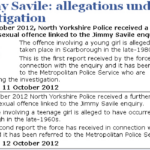Police Reform: Police Chiefs support NYE
A Letter to the Editor from NYE crime correspondent TIM HICKS.
~~~~~
Sir,
You will no doubt remember that in our article Cleveland Police a force in trouble Chris Clark and I advocated reform of policing in North East England by amalgamating Cleveland Police with North Yorkshire Police (NYP) and/or Durham Constabulary:
“Cleveland Police was formed in 1974 as an amalgamation of Teesside Constabulary with part of the York and North East Yorkshire Police and part of Durham Constabulary. Other than the unique area of 1.1. square miles covered by the City of London Police, its police area is the smallest geographically in the UK. The individual operational areas (BBC report here), Dog Sections and serious crime investigations (Yorkshire Post article here) of North Yorkshire, Cleveland and Durham police forces are merged as part of their Evolve Programme to “save money and become more efficient”.
It would be difficult enough to justify the expense of maintaining a force headquarters, Chief Constable, Deputy Chief Constable and Assistant Chief Constables for such a small force which has merged many of its functions into its two neighbours, even without the constant stream of corruption scandals. Under the present circumstances, it is impossible.
The only effective solution to obtain efficiencies and higher professional standards from Cleveland Police is root and branch reform. That is, to merge Cleveland Police with Durham Constabulary or split it between North Yorkshire Police and Durham.”
As a young man, I remember the furore over police incompetence and the refusal of different police forces to work together arising from the bungled “Black Panther” investigation in which NYP participated and then the catastrophically bungled “Yorkshire Ripper” enquiry, which NYP did not feature in, but should have. NYE investigations here, here, here and here.
At the time, there were calls for a national police force, or at least a national CID, because it was clear that individual police forces would not co-operate in investigations that covered multiple force areas and the present system of forty-three individual police forces was operationally inefficient. Needless to say, every Chief Constable in the land was determined to prevent this because it would mean losing control over the CID and numerous Chief Police Officers would lose their jobs. Hence, nothing came of it at the time
Consequently, the police service in England and Wales is still inefficient and each force defends its reputation jealously; even if this means supressing evidence of police misconduct or incompetence. Some examples of this in NYP are:
- The cover up by NYP to evade admitting that it had known all about the Peter Jaconelli/Jimmy Savile paedophile ring in Scarborough.
- The current refusal by NYP to respond to fresh witness evidence uncovered by the NYE in the “Nude in the Nettles” investigation into “Hope’s murder”, which was catastrophically bungled by NYP.
It should be noted that Northern Ireland always had a national force and Scotland successfully abolished eight regional forces to form a national force in 2013.
The article Cleveland Police a force in trouble calling for structural reform and the merger of police forces was published on the 24th of June 2019. I was very pleased to read that on the 4th of July 2019 Sir Thomas Windsor had also called for structural reform, in his annual assessment of policing in England and Wales. In his report, Sir Thomas stated that there was “continued controversy” about the 43 police force structure in England and Wales and the police service needed to operate as a single law enforcement system. BBC article here.
Then, on the 5th of July 2019, eight retired Chief Police Officers wrote to The Times newspaper calling for a royal commission on policing and reforming the current “fragmented” system of area forces. BBC article here. The Chief Police Officers were:
- Lord Condon (Metropolitan Police Commissioner 1993-2000)
- Lord Stevens of Kirkwhelpington (Metropolitan Police Commissioner 2000-05)
- Lord Blair of Boughton (Metropolitan Police Commissioner 2005-08)
- Sir Paul Stephenson (Metropolitan Police Commissioner 2009-11)
- Lord Hogan-Howe (Metropolitan Police Commissioner 2011-17)
- Sir Keith Povey, HM chief inspector of constabulary (2002-05)
- Sir Hugh Orde, president, Association of Chief Police Officers (2009-16)
- Sir Mark Rowley, assistant commissioner specialist operations, Metropolitan Police (2011-18)

Clockwise from top left:
Chief Police Officers calling for structural reform of police forces:
Sir Hugh Orde; Lord Condon; Lord Stevens; Lord Hogan-Howe; Sir Paul Stephenson; and Lord Blair
Sir Mark Rowley, who signed the letter is quoted in the BBC article above: “We’re saying it needs a fresh look at a national level in terms of how to organise policing to deal with the threats of today.” Essentially the same view Chris Clark and I expressed in our article, only on a national basis.
The BBC article states that between September 2009 and September 2017, police forces in England and Wales lost more than 20,000 officers – a drop of 15%. Cuts in expenditure have affected NYP across most areas. So far as I can ascertain, the only area in NYP that is unaffected by the cuts is Chief Constable Winward’s expenses for foreign travel.
The point being that each individual regional force has a Chief Constable, one or two Deputy Chief Constables, two or three Assistant Chief Constables, a Chief Finance Officer, a force headquarters in some cases following different force policies to other forces, a Police Fire and Crime Commissioner and a Police Fire and Crime Commissioner’s Headquarters, which often replicates the finance, IT and Corporate Communications functions performed at force headquarters. There is a huge cost to this.
Returning to the Cleveland example, serious crime investigations and individual operational areas operate on a regional basis and it is difficult to see what additional value the Chief Constable of Cleveland Police, Police Fire & Crime Commissioner for Cleveland and their respective headquarters provide in real terms.
Amalgamation of North Yorkshire, Cleveland and Durham Constabularies into a regional force would remove two Force Headquarters, two Chief Constables, two Deputy Chief Constables, two Police Fire & Crime Commissioners and their headquarters. Thereby making cost savings for no appreciable diminution in operational policing, or the number of operational police officers on the ground.
Yours faithfully,
Tim Hicks



























Comments are closed.